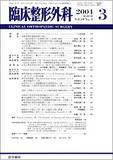Japanese
English
- 有料閲覧
- Abstract 文献概要
- 1ページ目 Look Inside
抄録:四肢骨腫瘍手術の際,腓骨を再建材料として用いることがよくある.腓骨は骨幹部がなくても障害はないとされるが,経過観察の際の画像検査で,腓骨採取側の足関節やけい骨に負荷がかかっていることを示唆する所見をみることがある.したがって,腓骨の再建が必要であるとの考えから,われわれは,腓骨の再生を期待し,腓骨欠損部に骨補填材料としてβ-tricalcium phosphate(オスフェリオン)を使用してきた.対象は,骨腫瘍に対し腓骨移植を行った症例14例で,経時的X線変化について検討した.平均経過観察期間は16カ月で,14例中12例で,平均43日でオスフェリオンを架橋する仮骨形成が認められ,12例中11例で,平均9.3カ月で骨梁の再開が認められた.特に小児例は全例早期に腓骨再生が得られた.血管柄付き腓骨採取例では,腓骨の再生はみられなかった.腓骨再生により,腓骨欠損後の下腿・足関節の障害を防ぐ可能性がある.
The fibula has often been used for reconstruction of bone defects after resection of bone tumor resection of the extremities. Resection of the fibular diaphysis has been harmless, but image examination during follow-up sometimes shows findings that suggest an increased load on the tibia and ankle at the fibula donor site. We have used β-tricalcium phosphate (β-TCP) as a bone substitute material for bone defects after fibula resection in anticipation of regeneration of the fibula. We assessed 14 patients radiographically after resection of the fibula for use as a bone graft following resection of a bone tumor. The mean follow-up period was 16months. Callus formation bridging across a β-TCP was observed in 12 of the 14 patients on average of 43 days after surgery. By an average 9.3months after surgery β-TCP had largely been absorbed and replaced by newly formed bone in 11 of 12 patients. In children, β-TCP was absorbed and replaced by regeneration of neofibula in the early stage after surgery. In a case of harvesting free vascularized fibula, regeneration of the fibula was not observed. Our results indicate that fibula reproduction by implanting β-TCP into a bone defect can prevent morbidity of the leg and ankle after harvesting free fibula.

Copyright © 2004, Igaku-Shoin Ltd. All rights reserved.


